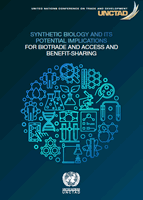
Synthetic biology was identified as an emerging issue meriting further research at the first meeting of the UNCTAD BioTrade Initiative Stakeholder Steering Committee meeting in 2018. This first study on the implications of synthetic biology for BioTrade was developed based on this request in order to provide guidance and further comprehension of the topic, especially its implications for BioTrade. BioTrade partners are expected to further support this line of work to enhance knowledge and provide practical experiences that enrich the findings in this study.
Although there is no universally agreed upon definition of the term ‘synthetic biology’, the 13th Conference of the Parties (COP) to the Convention on Biological Diversity acknowledged the following definition as a useful starting point for continued discussions: “a further development and new dimension of modern biotechnology that combines science, technology and engineering to facilitate and accelerate the understanding, design, redesign, manufacture and/or modification of genetic materials, living organisms and biological systems.” As such, it falls within the scope of the Convention and its Protocols on biosafety and access and benefit-sharing (ABS).
Through this study, particularly the case studies, UNCTAD aims to show the potential implications of synthetic biology for BioTrade and ABS. From the research carried out, it appears that synthetic biology will not have direct impacts on all BioTrade sectors, as existing technologies mainly target specific market sectors such as the cosmetics sector, food and fragrances sector, and pharma/phytopharmaceutical sector. The most foreseeable consequence for BioTrade is the displacement of naturally sourced ingredients with ingredients produced through the use of synthetic biology. However, displacement in the BioTrade sector may be limited, as consumers purchasing products with BioTrade ingredients are likely looking to purchase products produced in line with economic, social and environmental sustainability criteria and are less likely to be influenced by cost savings resulting from the use of synthetic biology ingredients. This trend is especially strong with younger consumers.
Many of the implications of synthetic biology for BioTrade remain prospective because most synthetic biology companies are not yet producing economically competitive products. Given this, it is an opportune time for BioTrade actors to take a proactive approach to this matter. Based on the analysis conducted in the study, several recommendations for BioTrade can be made. These recommendations offer different possible approaches to addressing synthetic biology in the revised BioTrade Principles and Criteria (BT P&C), and addressing its implications for the sustainable use of biodiversity more broadly.
Recommendations:
-
Provider countries may want to consider conducting socioeconomic impact assessments for nationally important value chains when a synthetic biology alternative appears on the market in order to determine its potential impact on jobs and livelihoods.
-
Where there is a significant risk to jobs and livelihoods, it may be appropriate for provider countries to assist producers to transition to different BioTrade value chains to prevent the impact on livelihoods and biodiversity that would result from a shift away from the existing value chain.
-
Consider the need and potential implications of defining “natural product” or “goods and services derived from native biodiversity” in the context of BioTrade. This would be a challenging undertaking and it may be preferable to leave this to national decision makers and standard-setting bodies.
-
Consider addressing how the BioTrade Principles and Criteria address specific types of technologies or products falling under the broad scope of synthetic biology. This may include the question of whether a broad approach is preferable, or whether a case-by-case approach based on sustainability criteria is appropriate.
-
Consider whether a case-by-case approach to the use of products fabricated with genetically modified/ synthetic biology organisms in BioTrade products is appropriate where they are demonstrably more sustainable than their naturally derived counterparts (e.g. where there is a trade ban under CITES, listed on the International Union for Conservation of Nature (IUCN) Red List).
-
If a case-by-case approach is adopted, consider the development of a traceability mechanism for ingredients that are derived from CITES-listed species to prove that they have been fabricated using SynBio processes and not directly from these species.


